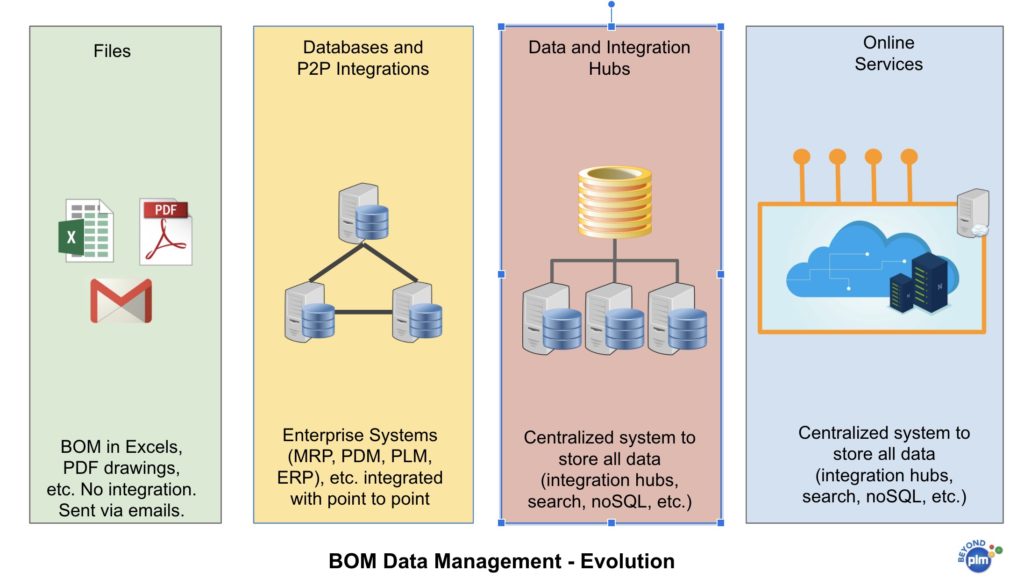
My recent blog about how to integrate BOMs and also the opportunity to have a Single BOM? brought many questions about how companies are organizing data to manage bills of materials. One of them how to integrate multiple BOMs? Another was about creating a single BOM to maintain all product structure representation – eBOM, mBOM, sBOM, and others single information set and be able to filter the right one based on the role, lifecycle state, and revision. One of the most valid questions I’ve got was about the cost to create such a data representation. Technology can do magic, but in most cases, the technology can only do as much as a company that is ready to adopt the technology.
This brings me to discuss the history of BOM data management and what I can see as the trajectory for future Bill of Materials data representations and systems. BOM management is an essential part of many systems, you can see it in CAD, PDM, PLM, MRP/ERP, and many others. In the picture below, I outlined four distinct stages in the development of BOM data management. The borders between them are blurred. Let me talk about each of them.

1- Files (and emails)
Historically BOM was always found in the drawings. It is widely available, supported by all CAD systems, and doesn’t require any special tools. It is still the desired outcome for any engineering work – to provide a part list in the drawing. These BOMs are usually part of the release process, but they are not tracked well and cannot be referenced in any form.
Excel and other spreadsheets is another goldmine to find tons of bills of materials. Excels are easy to start and widely used. The amount of work engineers (still) do in Excel is huge. BOM in Excel is a pain, but when other tools are too expensive or too complex, this is a place where many BOM users are going to get the job done.
The main problem with both PDF files and spreadsheets is lack of traceability, absence of structure, hierarchy, and referenceability. Each BOM is separate, to manage the structure is impossible.
2- Databases and Point to Point Integrations
Databases came to use and manage BOM first in MRPII programs. BOMs is a foundation of material resource planning and databases (first proprietary and later SQL based) became widely used to manage part lists and BOMs. The same happened with early PDM and PLM software. Although PDM/PLM was more focused on the management of CAD documents first, BOM and product structure are essential for many companies to manage and these databases used a lot. Still, this is one of the most popular ways to manage BOMs.
Databases became the first place where companies started to divide between different types of BOMs or BOMs used at different lifecycle stages – eBOM, mBOM, sBOM, etc. The fight between enterprise systems for BOM ownership is an ongoing battle these days. Each vendor (or domain such as PLM, ERP, etc.) is claiming the ownership of the data. As a result, tons of point-to-point integrations were developed to sync data between different databases and storage.
3- Enterprise databases and integration hubs
This is an advanced stage of BOM management solutions- a natural progression from the previous one -databases and point to points. The ability of enterprise systems was advanced and integration capabilities allowed us to introduce “hubs” as a way to consolidate data from multiple systems and integrate them more intelligently.
The technologies to organize hubs have been advancing for the last two decades. What started as a messaging hub to integrate data, today is expanding as advanced data management solutions using analytics, NoSQL databases, search indexes, semantic data, graph databases, and many other technologies to bring heterogeneous data sets together and align BOMs and product structure between different systems and structures.
4- Online servies
Advanced technologies and the development of web and cloud-based systems bring a lot of novelty in the way systems can manage data and integrate the information. These technologies are partially a continuation of advanced data management techniques used for data hubs, indexes, and graphs. The availability of highly available global online services and multi-tenant technologies made it possible to introduce business scenarios and support that was not available until very recently.
Companies are re-architecting their systems and looking at how to simplify data management and consolidate siloed data sources where it is possible. In such a way, BOM and product structures are becoming a strategic enterprise data asset that can be reused in multiple systems. PLM and some other vendors are capable of introducing an online service providing information access to other business applications and allowing to use of BOM and product structure information in a more rational way.
What is my conclusion?
BOM started its life as a simple list in the drawing and Excel file. Nowadays, product structure and BOM are important data assets to build digital twins and make data universally available across the enterprise and multiple vendors, contractors, and suppliers. The future rationalization and advanced technologies for data management architecture to support product information will make data access and analytics to support companies for decision support in many business scenarios such as cost management, purchasing, production, supply chain, and others, Just my thoughts…
Best, Oleg
Disclaimer: I’m co-founder and CEO of OpenBOM developing a digital network-based platform that manages product data and connects manufacturers and their supply chain networks. My opinion can be unintentionally biased.
The post BOM Data Management Evolution appeared first on Beyond PLM (Product Lifecycle Management) Blog.



Be the first to post a comment.